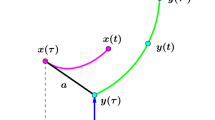Abstract
A differential game of pursuit and evasion on the real line is discussed with one pursuer and two evaders, the motion of the players being affected by noise. The game of degree is considered, where the pursuer strives to maximize the probability of his winning the game, i.e., of capturing at least one of the evaders, the probability function being given as a solution to a certain partial differential equation; the heat conduction analogy is also being discussed. The degenerate situation here arises in a natural way, and it is possible to present a quite detailed analysis of this case.
Similar content being viewed by others
References
Pontryagin, L. S., et al.,The Mathematical Theory of Optimal Processes, John Wiley and Sons (Interscience Publishers), New York, New York, 1962.
Mishchenko, E. F.,On a Certain Problem for Parabolic Differential Equations Connected with Optimal Pursuit, SIAM Journal on Control, Vol. 3, pp. 66–70, 1965.
Kushner, H. J.,Stochastic Stability and Control, Academic Press, New York, New York, 1967.
Gikman, I. I., andSkorohod, A. V.,Stochastic Differential Equations, Springer-Verlag, Berlin, Germany, 1972.
O'Connor, G. E., andLuh, J. Y. S.,Suboptimal Controls that Maximize the Probability of Entering a Target Manifold, IEEE Transactions on Automatic Control, Vol. AC-13, pp. 639–645, 1958.
Luh, J. Y. S., andO'Connor, G. E.,Approximate Optimal Controls that Maximize the Probability of Hitting a Target Manifold, Journal of the Franklin Institute, Vol. 288, pp. 1–15, 1969.
Katayama, T.,Optimal Bang-Bang Controls that Maximize the Probability of Hitting a Target Manifold, International Journal of Control, Vol. 15, pp. 737–750, 1972.
Pachter, M., andYavin, Y.,Speed Control of a Field-Controlled DC Motor by Probability Maximization (to appear).
Pachter M., andYavin, Y.,A Stochastic Homicidal Chauffeur Pursuit-Evasion Differential Game, Journal of Optimization Theory and Applications, Vol. 34, No. 3, pp. 405–424, 1981.
Strook, D. W., andVaradhan, S. R. S.,Diffusion Processes with Continuous Coefficients, Communications on Pure and Applied Mathematics, Vol. 22, pp. 345–400 and pp. 479–530, 1969.
Park, C., andSchuurman, F. J.,Evaluations of Barrier-Crossing Probabilities of Wiener Paths, Journal of Applied Probability, Vol. 13, pp. 267–275, 1976.
Author information
Authors and Affiliations
Additional information
Communicated by G. Leitmann
This work was partially supported by a grant from Control Data.
Rights and permissions
About this article
Cite this article
Pachter, M., Yavin, Y. One pursuer and two evaders on the line: A stochastic pursuit-evasion differential game. J Optim Theory Appl 39, 513–539 (1983). https://doi.org/10.1007/BF00933756
Issue Date:
DOI: https://doi.org/10.1007/BF00933756



